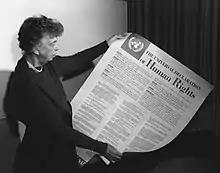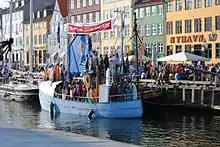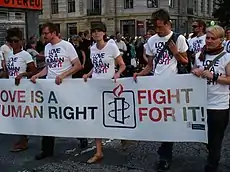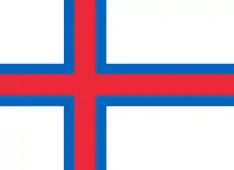Human rights in Denmark
Human rights in the Kingdom of Denmark are protected by the state's Constitution of the Realm (Danmarks Riges Grundlov); applying equally in Denmark proper, Greenland and the Faroe Islands, and through the ratification of international human rights treaties.[1] Denmark has held a significant role in the adoption of both the European Convention on Human Rights and in the establishment of the European Court of Human Rights (ECHR). In 1987, the Kingdom Parliament (Folketinget) established a national human rights institution, the Danish Centre of Human Rights, now the Danish Institute for Human Rights.[1]
 |
|---|
| This article is part of a series on the politics and government of Denmark |
|
|
While Denmark and other Scandinavian countries have historically been "defenders of international law and human rights",[2] many issues in regard to human rights still exist or have emerged in recent times. Amnesty International have reported numerous human rights violations against refugees, immigrants and asylum seekers and have described Danish policies towards immigrants as some of the most aggressive in the Western world.[3] There have also been issues with violence against women and the rights of LGBTQI people.[4]
History
Constitutional Act of the Realm of Denmark
Section 71
The Kingdom of Denmark is a constitutional monarchy. The Constitutional Act or (Grundloven), which was adopted on 5 June 1849, lays the foundations of democracy in the organisation of the Realm of Denmark.[5]
The Constitution has been amended three times since its adoption in 1849. The most significant of these amendments occurred in 1953, leading to the Constitution in use today, as it granted "clear constitutional authority to share Denmark's sovereignty with other countries".[6] This was important as it aimed to prepare Denmark for the potential membership to the European Union.[6]
While the role of the Constitutional Act is to restrict the authority of the monarchy, it is also to ensure that human rights as well as civil and political rights are guaranteed for Danish citizens.[7] Examples of these include the right to Personal Liberty (Section 71), Freedom of Expression (Section 77) and Freedom of Assembly (Section 79).
In addition, the Constitution guarantees Freedom of Religion (Section 67), provided that these religious communities do not threaten "good morals or public order".[8]
These rights, enshrined in the Constitution, enjoy "special status.".[7] In addition, as outlined in Section 88 of the Constitution, these rights are the "supreme source of Danish law"[7]
European Convention on Human Rights
The European Convention on Human Rights (ECHR) is a treaty that was ratified by 47 member states of the Council of Europe on 3 September 1953.[9] The aim of the treaty is to both "protect the rule of law"[9] and to endorse democracy in Europe. The European Convention was the first treaty to provide institutional means of supervising and enforcing human rights across Europe.[10] To achieve this, the Convention established two enforcement measures - the European Commission of Human Rights and the European Court of Human Rights.
Although ratified in 1953, the Convention was not incorporated in Danish law until 29 April 1992. As a result of its incorporation in domestic law, courts of Denmark have a duty to enforce the Convention.[11] The European Convention on Human Rights is the only treaty concerning human rights in Danish law at present.[7] Significant civil and political rights that are guaranteed by the European Convention on Human Rights include the right to liberty, right to a fair trial, freedom of thought, conscience and religion and freedom of expression.[12]
European Court of Human Rights
The European Court of Human Rights (ECtHR or ECHR), established in 1959 by the European Convention on Human Rights, is the Council of Europe's court of law. Its purpose is to examine and make judgments on complaints of alleged human rights violations.[13]
In the early stages of the ECtHR's foundation, the Scandinavian countries were some of the first to agree to the optional clauses on its jurisdiction, thus strengthening its political legitimacy.[2] In addition, Denmark and the other Nordic states were prominent figures in the preliminary construction of the ECtHR system, and in its finalisation.[2]
Key topics in the Constitution

Section 71: Personal liberty
Section 71 of the Constitution focuses on inalienable rights, as well as ensuring citizens' protection from unreasonable restraint and guaranteeing one's right to a fair trial. The direct quote below outlines the fact that a Danish citizen cannot be detained due to their religion, race or political view:[5]
Personal liberty shall be inviolable. No Danish subject shall in any manner whatever be deprived of his liberty because of his political or religious convictions or because of his descent.
Section 77: Freedom of expression
Section 77 of the Constitution guarantees freedom of speech, and freedom of the press, both of which are recognised as human rights under the Universal Declaration of Human Rights (UDHR). While the government largely respects these rights, legal restrictions are in place for libel, blasphemy and racism.[14]
In March 2015, discussions surrounding the removal of legal restrictions for blasphemy were suspended as the Government of Denmark confirmed that its anti blasphemy law would remain in place.[14]
Section 79: Freedom of assembly
Section 79 of the Constitution protects citizens' right to gather for peaceful assembly. This is recognised as a human right under international human rights instruments such as the Universal Declaration of Human Rights and the European Convention on Human Rights. Freedom of Assembly is understood as the right to protest peacefully, and without arms.
Section 79 also provides that if an assembly is a threat to public peace, it may be dissolved by the police.[8]
Freedom of religion
Section 67: Freedom of religion
Freedom of religion is regarded as a fundamental human right, as outlined in Article 18 of the Universal Declaration of Human Rights. In addition it is entrenched in Section 67 of the Danish Constitution, which provides that citizens are entitled to establish and join religious congregations or communities. However, it also specifies that a religious group may not present a threat to "good morals or the public order".[8]
With the current rise in religious extremism, government restrictions on religion are beginning to increase.
Examples include the Kingdom parliament's ban on wearing face veils, enacted in May 2018.[15] This law is seen as problematic as it targets less than 0.1% of Denmark's population — Muslim women whose choose to wear the niqab or the burqa.[15]
In addition, a law introduced in 2019 requires a person to shake hands with officials at their naturalisation ceremony if they wish to take Danish citizenship.[16] This has prompted human rights concerns in regard to freedom of religion as it is argued it targets Muslim and Jewish groups who demonstrate "lack of assimiliation".[16] The Danish Government, however, maintains that this law has been established solely to elevate a "social custom to a national value".[16]
Sources of human rights in international law
Universal Declaration of Human Rights

Following the atrocities of World War II, the international community established the United Nations in 1945. In order to promote international peace and equality, they developed the Universal Declaration of Human Rights (UDHR), which was adopted by the United Nations General Assembly on 10 December 1948. The declaration was established as "a common standard of achievements for all peoples and all nations".[17]
The UDHR was the first of its kind, as it was a codification of human rights without discrimination and incorporated entitlements that related to all spheres of human life and personality.[18] Although it is not a treaty and therefore not legally binding, it was hoped that it would serve as a model for domestic laws and later binding treaties.[18] In addition, the UDHR, which is still in use today, acts as a mechanism to uphold values such as "universal equality and freedom, supporting decolonisation, good governance and the struggle against discrimination".[18]
Involvement in international human rights campaigns
On 21 April 1967, the elected government in Greece was overthrown in a coup d'état led by a group of Greek colonels (military junta) In September 1967, the Nordic states including Denmark, Sweden, Norway and the Netherlands appealed to the European Commission of Human Rights to hold Greece accountable for their violation of what are considered to be human rights by the European Convention on Human Rights.[19] As a result, the Council of Europe passed a resolution on 15 April 1970 that made the Report of the Human Rights Commission on the Greek Case public.[20] This report found that, as initially put forward by the Nordic states, many of the human rights under the European Convention on Human Rights had been violated by the Greek government.[20]
Furthermore, from the 1970s the Nordic states played a significant role in supporting non-governmental human rights organisations and actors.[21] For example, the Helsinki Watch, a non-governmental organisation based in the U.S. and established in 1978, was crucial to advocating for human rights in this period.[22] The Helsinki Watch led the formation of the International Helsinki Federation for Human Rights (IHF) founded in 1982.[22] As early as 1985, the IHF had committees in a number of European countries including Denmark. This early support for international human rights is what has secured its reputation in Denmark as a "vehicle of progressive change."[21]
Current issues
Refugees and asylum seekers

Denmark is argued by some to have some of Europe's "most aggressive anti-immigrant policies."[23] The people of Denmark are largely divided in their opinions on immigration - some accepting of it and others who are concerned and thus want restrictive policies in place.[23] In 2016, the Danish annulled its agreement with the United Nations High Commissioner for Refugees (UNHCR) that stated that it would receive 500 refugees on an annual basis for resettlement.[4]
In 2018, Denmark announced that it would no longer resettle refugees under the United Nation's quota system, with the decision to accept refugees being made by the government and not the parliament.[4]
In addition, in late 2018 the Danish government announced that the 2019 budget would include funding for a scheme that would see foreign criminals who had completed jail sentences, but could not be deported, to be moved to Lindholm Island.[24] Lindholm Island is located two miles out from the southeast of Denmark, and had previously been a laboratory for animals with highly contagious diseases.[25] The policy has been labelled as being "barbaric" and "deeply repulsive."[25]
Violence against women
The Istanbul Convention (the Council of Europe Convention on Preventing and Combating Violence against Women and Domestic Violence), which was ratified by Denmark in 2014, classifies "rape and all other non-consensual acts of a sexual nature" as being criminal offences.[26] However, the definition of rape in domestic Danish law is not based on the notion of consent and is instead based on the presence of "physical violence, threat or coercion" or "if the victim is found to have been unable to resist."[26]
This is deemed to be problematic as the assumption that a victim gives their consent to a sexual act if they do not resist it physically ignores the possibility of "involuntary paralysis" or "freezing," and thus the inability to resist.[26]
In April 2018, the Danish opposition proposed the introduction of a "consent-based definition of rape" as outlined under the Istanbul Convention.[4] This was rejected in Parliament. In addition, pressure was put on the Danish government by the Council of Europe's Group of Experts on Action against Violence against Women and Domestic Violence (GREVIO) to adapt its sexual violence legislation to include the notion of "freely given consent."[4]
A report published by Amnesty International in March 2019 states that women in Denmark rarely reported rape due to a "lack of trust in the justice system" and the poor treatment of victims throughout the legal process.[26]
Indigenous rights
On 18 January 1996, Denmark ratified the international Indigenous and Tribal Peoples Convention, 1989 (ILO-convention 169)[27] and voted in favour on the adoption of the proposal of the international Declaration on the Rights of Indigenous Peoples on 13 September 2007.[28]
Denmark has one officially recognized Indigenous group, the Inuit - the Greenlandic Inuit of Greenland and the Greenlandic people in Denmark (Inuit residing in Denmark). Despite there being around 70.000 people living and identifying as an Inuk person, there is no official state registry defining the Inuit people as Indigenous nor as a distinct people in the Kingdom of Denmark. Greenlandic Inuit are as nationals of Greenland, Citizens of the Realm of Denmark, and also EU citizens due to Greenlands associated relationship with the European Union.
The Inuit are indigenous to the Arctic and have traditionally inhabited Greenland and the northern parts of Canada and Alaska. The Inuit have for decades been the subject of discrimination and abuse by the dominant colonisers from Europe, those countries claiming possession of Inuit lands. The Inuit have never been a single community in a single region of Inuit.[29]
From the 18th century up to the 1970s, the Danish government (Dano-Norwegian until 1814) have through time tried to assimilate the Greenlandic Inuit, encouraging them to adopt the majority language, culture and religion. Denmark has been greatly criticised by the greenlandic community for the politics of Danization (50's and 60's) of and discrimination against the indigenous population of the country. Critical treatment paying non-Inuit workers higher wages than the local people, the relocation of entire families from their traditional lands into settlements, and separating children from their parents and sending them away to Denmark for schooling has been practiced.[30][31]
In Denmark the Greenlandic Inuit have the same rights as everyone else with Danish citizenship. But people with a Greenlandic Inuit background face a number of challenges in relation to enjoying equal treatment and opportunities as to other nationals of the realm.[32] In general, Greenlanders are not considered an ethnic minority, although some experience special linguistic, cultural and social challenges in Danish society in line with citizens with an ethnic minority background.
In Greenland the Inuit still maintain traditional Indigenous practices, such as hunting and fishing. The Inuit were subjugated under Danish colonial rule from 1721 up through the twentieth century. In 1953, Greenland became a fully integrated part of the Realm of Denmark as the County of Greenland whereas Denmark implemented a severe policy of modernization through urbanization, relocating the Inuit from their small, subsistence-based communities to major cities. In 1979, Greenland successfully lobbied for autonomy from Denmark and achieved a Home Rule Government, which was expanded to Self-Government in 2009.
Denmark's initial relationship with its Indigenous Population reflected typical Western European imperialism.
Until this day Greenlands autonomy is still not protected by the Danish constitution. Greenland is still a stateless nation with its people that does not possess their own state,[33] and do not have the majority population within the unitary nation state of the Kingdom of Denmark.[34] The term "stateless" implies that Greenland and its people "should have" such a state (country).[35][36] In contrast to if the Kingdom of Denmark was a multinational state that comprises Denmark, Greenland and the Faroe Islands as equal nations or states within the Kingdom in a federation, giving their sovereignty to each other.
Greenland is not a member of any State Government, Council of State and neither Council of Ministers of the Kingdom, but have achieved limited settlement lobbied by the Greenlandic MPs in the Kingdom Parliament (Folketinget).
Rights of LGBT people

Denmark was the first country to recognise registered partnerships (Danish: registreret partnerskab) between same-sex couples, in a law enacted on 7 June 1989. This granted LGBT people many of the same rights as heterosexual couples; however it did not grant them "the right to adopt or obtain joint custody of a child".[37] On 15 June 2012, Denmark became the eleventh country in the world to legalise same-sex marriage, the existing law being replaced by gender-neutral marriage legislation.[38]
In January 2016, a resolution was implemented by the Danish parliament which prevented transgender being classified as a mental health condition.[4] In doing so, Denmark became the first country in Europe to go against the World Health Organisation (WHO) standards, which classified transgender identity as being a mental health issue until June 2018.[39][40] However, in their 2017/2018 report on 'The State of the World's Human Rights', Amnesty International flag the current procedural rules surrounding access of transgender people to hormone therapy and gender-affirming surgery to be an issue, arguing that they "unreasonably prolong the gender recognition process."[4]
In addition, Amnesty International revealed that the Danish Health Authority has not yet established national guidelines outlining how children with variations of sex characteristics should be treated by doctors.[4] As a result, "non-emergency invasive and irreversible medical procedures" may be conducted on children under the age of 10.[4] This directly violates the UN's Convention on the Rights of the Child.
See also
 Kingdom of Denmark portal
Kingdom of Denmark portal Denmark portal
Denmark portal Faroe Islands portal
Faroe Islands portal
References
- "Human rights in Denmark". The Danish Institute for Human Rights. The Danish Institute for Human Rights. Retrieved 2019-05-14.
- Ersen, J; Madsen, M (2011). "The End of Virtue? Denmark and the Internationalisation of Human Rights". Nordic Journal of International Law. 80 (3): 257–277. doi:10.1163/157181011X581164.
- "An Island for 'Unwanted' Migrants Is Denmark's Latest Aggressive Anti-Immigrant Policy". Time. Retrieved 2020-11-11.
- Amnesty International (2018). "Amnesty International Report 2017/2018" (PDF). Amnesty International.
- "The Constitutional Act of Denmark". Folketinget: The Danish Parliament. Retrieved 2019-05-14.
- Gylfason, Thorvaldur (2017). "The Anatomy of Constitution Making: From Denmark in 1849 to Iceland in 2017" (PDF). CESifo Working Paper Series.
- "Human rights in Danish law". The Danish Institute for Human Rights. The Danish Institute for Human Rights. Retrieved 2019-05-14.
- "Denmark - Constitution". www.servat.unibe.ch. 1992. Retrieved 2019-05-16.
- "What is the European Convention on Human Rights?". Human Rights in the UK. Amnesty International UK. 2018. Retrieved 2019-05-16.
- Ma, Yue (2000-05-01). "The European Court of Human Rights and the Protection of the Rights of Prisoners and Criminal Defendants Under the European Convention on Human Rights". International Criminal Justice Review. 10 (1): 54–80. doi:10.1177/105756770001000104. ISSN 1057-5677.
- "European Convention on Human Rights". The Danish Institute for Human Rights. The Danish Institute for Human Rights. Retrieved 2019-05-18.
- "Complete list of the Council of Europe's Treaties". Council of Europe. Council of Europe Treaty Office. Retrieved 2019-05-17.
- "What is the European Court of Human Rights?". Equality and Human Rights Commission. Retrieved 2019-05-18.
- "Denmark". Freedom House. Freedom House. 2016-03-10. Retrieved 2019-05-18.
- Reuters in Copenhagen (2018-08-01). "Protests in Denmark as 'burqa ban' comes into effect". The Guardian. ISSN 0261-3077. Retrieved 2019-06-07.
- Sorensen, Martin Selsoe (2018-12-20). "Denmark, With an Eye on Muslims, Requires New Citizens to Shake Hands". The New York Times. ISSN 0362-4331. Retrieved 2019-05-18.
- "Universal Declaration of Human Rights". United Nations. United Nations. 2015-10-06. Retrieved 2019-05-28.
- Ferstman, Carla; Gray, Tony (2018). Contemporary Human Rights Challenges: The Universal Declaration of Human Rights and its Continuing Relevance. Boca Raton, FL: Routledge. pp. x–2.
- Blum, William (2004). Killing Hope: U.S. Military and CIA Interventions Since World War II (2nd ed.). Common Courage Press.
- Becket, James (August 1970). "The Greek Case Before the European Human Rights Commission". Human Rights. American Bar Association. 1 (1): 91–117. JSTOR 27878926.
- Vik, Hanne Hagtvedt; Jensen, Steven LB; Lindkvist, Linde; Strang, Johan (October 2018). "Histories of Human Rights in the Nordic Countries". Nordic Journal of Human Rights. 36 (3): 189–201. doi:10.1080/18918131.2018.1522750.
- Snyder, Sarah B (2011). Human Rights Activism and the End of the Cold War: A Transnational History of the Helsinki Network. Cambridge University Press. pp. 115–120.
- Abend/Vordingborg, Lisa (2019-01-16). "An Island for 'Unwanted' Migrants Is Denmark's Latest Aggressive Anti-Immigrant Policy". Time. Retrieved 2019-06-07.
- Reuters (2018-12-20). "Denmark approves plan to send foreign criminals to tiny island". The Guardian. ISSN 0261-3077. Retrieved 2019-06-08.
- Gargiulo, Susanne; Guy, Jack (2018-12-06). "Denmark plans to isolate 'unwanted' migrants on remote island". CNN. Retrieved 2019-06-08.
- "Denmark: Pervasive "rape culture" and endemic impunity for rapists exposed". Amnesty International. Retrieved 2019-06-07.
- "Ratifications for Denmark" ilo.org
- Indigenous rights outlined by UN Archived September 28, 2013, at the Wayback Machine BBC News, 13 September 2007.
- The Inuit of the Arctic
- Long-term Effects of Denmark's Colonization of Greenland
- Report published by the Greenland Reconciliation Commission
- Equal treatment of Greenlandic persons in Denmark conducted for the Danish Institute for Human Rights by the National Centre for Social Research, 15 May 2015.
- Dictionary Of Public Administration, U.C. Mandal, Sarup & Sons 2007, 505 p.
- Frank L. Kidner; Maria Bucur; Ralph Mathisen; Sally McKee; Theodore R. Weeks (2013), Making Europe: The Story of the West, Volume II: Since 1550, Cengage Learning, p. 668, ISBN 978-1-285-50027-0
- Osborne, Louise; Russell, Ruby (27 December 2015). "Stateless in Europe: 'We are no people with no nation'". Retrieved 28 December 2018.
- Chouinard, Stéphanie (2016), "Stateless nations", in Karl Cordell; Stefan Wolff (eds.), The Routledge Handbook of Ethnic Conflict, Routledge, pp. 54–66, ISBN 9781317518921
- Rule, Sheila (1989-10-02). "Rights for Gay Couples in Denmark". The New York Times. Retrieved 2019-06-05.
- "Gay marriage legalised". CPH Post Online. 2012-06-07. Retrieved 2019-06-07.
- Williams, Steve (2016-05-20). "Denmark to the WHO: Trans Identity Is Not a Mental Illness". Care2 Causes. Retrieved 2019-06-07.
- Simon, Caroline (2018-06-20). "Being transgender no longer classified as mental illness. Here's why". USA TODAY. Retrieved 2019-06-07.
External links
- Kingdom of Denmark
- Constitution of the Realm of Denmark
- Folketing Ombudsman
- The Danish Institute for Human Rights
- Human rights in Denmark, Office of the High Commissioner for Human Rights (OHCHR), United Nations
- Ratifications for Denmark, International Labour Organization (ILO), United Nations
- Faroe Islands
- The Constitutional Status of the Faroe Islands - Home-Rule Government of the Faroe Islands
- Løgting Ombudsman
- Declarations for the Faroe Islands, International Labour Organization (ILO), United Nations
- Greenland
- The Legal Frameworks - Self-Rule Government of Greenland
- Inatsisartut Ombudsman
- Human Rights Council of Greenland
- The Danish Institute for Human Rights Greenland Entry
- ICC Greenland
- Declarations for Greenland, International Labour Organization (ILO), United Nations
Freedom in the World Score, Freedom House[1]
| 2015 | 2016 | 2017 | 2018 | 2019 | ||||||||||||
|---|---|---|---|---|---|---|---|---|---|---|---|---|---|---|---|---|
| Country | PR | CL | Free | PR | CL | Free | PR | CL | Free | PR | CL | Free | PR | CL | Free | Pts |
| 1 | 1 | Free | 1 | 1 | Free | 1 | 1 | Free | 1 | 1 | Free | 1 | 1 | Free | 97 | |
- "Freedom in the World Countries | Freedom House". freedomhouse.org. Retrieved 2019-06-08.
